‘What is The Great Crate Debate?’ you may ask.
Well, the use of crates for domestic dogs is actually quite a contentious topic. Proponents believe them to be useful tools. Opponents believe that their use is cruel.
Who is right?
Let’s consider the pros and cons of crate training and then you can make your own assessment.
Has the Coronavirus / Covid-19 pandemic had any impact on the use of crates?
I conducted a survey to try to establish whether or not there has been any impact. I’ll show the results and attempt to draw some conclusions.
Affiliate Disclaimer
1 What is a Dog Crate?
OK, we can’t have a Great Crate Debate without knowing what a dog crate is, can we?
A dog crate, sometimes also referred to as a dog cage or indoor kennel, is usually made of a wire frame and has a removable tray base for the dog’s bedding. It commonly has 2 doors; one at the front and one at the side. It can be flat-packed for easier transportation.
They are available in a variety of sizes – obviously, one that is ideal for a Chihuahua will not be ideal for a Great Dane!
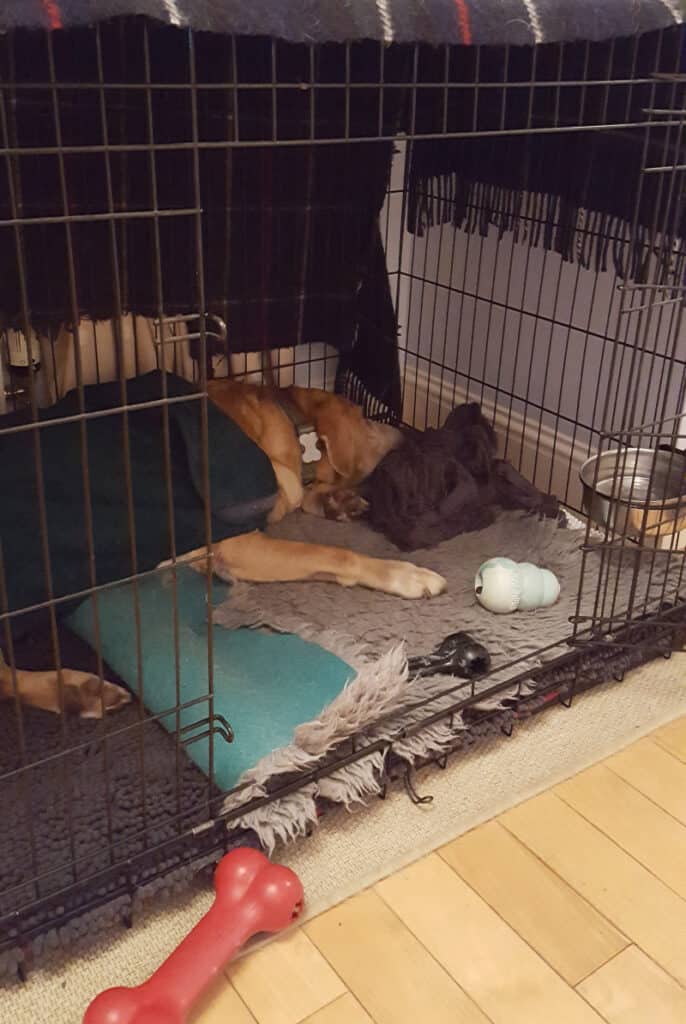
2 Proponents and the Case For the Use of Crates
The Great Crate Debate – Proponents
When considering which organisations are associated with dogs and their breeding and welfare, who do you think of?
In the UK, it is likely to be:
In the US, it is likely to be:
Clicking on the links attached to the name of each of these organisations will take you to a webpage where they discuss the advantages of dog crates and how you should go about training your dog to use a crate (Crate Training is discussed later in this post).
In addition to these organisations, a great many dog breeders, vets, and trainers also recommend crate training.
Give some thought to the names of the most well-known dog trainers and behaviourists today. Keep those names in mind when you reach the Crate Training section.

The Great Crate Debate – Advantages
So, what are the advantages of dog crates that are advanced by proponents?
- Limiting exercise. There are times when, on the advice of your vet, it may be necessary to restrict the amount of exercise that your dog gets. For example, if recovering from an operation.
- Dog protection. If you are unable to supervise your dog, or, in particular, puppy, then a crate is an ideal safe place for them until you are able to resume supervision. In addition, if you are a multi-dog household then it may be useful for separation of the dogs at feeding times to prevent any aggression.
- Sleeping area. A crate can be a great way of providing a warm, safe place for your dog to sleep at night.
- Puppy protection. There may be times when there are other dogs, or cats, in your home and you need to protect your puppy from getting into trouble.
- Home protection. Protects the contents of your home while you are unable to supervise – furniture, ornaments, carpet.
- Cat socialisation. If you have a cat and then acquire a dog, or a dog and then acquire a cat, it will be necessary to make gradual introductions such that neither party is injured.
- House training. A dog crate can be invaluable in helping your dog to become house trained.
- Preventing separation anxiety. Crate use can prevent separation issues. It can also, with appropriate guidance from a professional behaviourist, help to resolve any such issues.
- Transport. Transporting your dog in a crate is far safer than letting him run free.
- Holidays. Many providers of holiday accommodation now permit dogs to stay at their properties but often with the stipulation that the dog is in a crate at night, and also if you need to leave the dog in the property for any reason during the day.
3 Opponents and the Case Against the Use of Crates
The Great Crate Debate – Opponents
The group that seems most opposed to the use of dog crates is:
PETA is an animal rights group. Their philosophy is :
… we believe that it would have been in the animals’ best interests if the institution of “pet keeping”—i.e., breeding animals to be kept and regarded as “pets”—never existed.
PETA
Frankly, I’ve struggled to find any other well-known organisations that are opposed to the use of crates. There are, of course, individual opponents, as there are individual proponents. In the interests of balance, if you know of any such organisations please let me know in the ‘Comments’ section at the end of the post and I’ll consider amending this section.
That said, it has to be noted that there are countries, like Finland and Sweden, where the use of dog crates is illegal.
The Great Crate Debate – Disadvantages
Let’s take a look at what opponents of dog crates believe the disadvantages to be.
- House training. A crate does not help with house training because puppies can’t ‘hold it’ for their first few months of life.
- Separation anxiety. Crates cause separation anxiety, fearfulness, depression, ‘cage rage’, hyperactivity, and other types of behavioural problems.
- Confinement. A crate is not similar to a den. Dogs are prevented from engaging in basic normal activities and learning.
- Crate love. Dogs do not love their crates. They do as you ask because they love you.
- Tool. A crate is just a convenience tool for humans.
4 Crate Training

Trainers
When we mentioned Crate Training in part 2 I asked you to think of some well-known dog trainers. Who did you think of?
Victoria Stilwell. If you’ve watched any dog training programmes on TV then the chances are you’ll be familiar with this lady. She is a dog behaviour expert and one of the key figures in promoting the use of Positive Dog Training rather than the use of more ‘traditional’ dominance-based training.
If, on the other hand, you’ve obtained your dog training guidance from online sources then you are probably more familiar with these individuals:
Zak George. Zak has presented TV shows too but is probably best known for his YouTube training videos (see below for one on Crate Training). He is another keen proponent of Positive Dog Training methods.
Emily Larlham. Emily is best known for her ‘Kikopup’ dog training videos on YouTube. She believes in dog training that does not involve any form of physical or psychological intimidation. A ‘Kikopup’ Crate Training video is shown below.
Karen Pryor. Karen is a leader in the field of animal training and a recognised world leader in the science and application of marker-based positive reinforcement training (often called ‘clicker training’).
Sarah Whitehead. There are many expert dog trainers in the world, and Sarah is among them, but when you think of expert dog behaviourists it is likely that you think of Sarah before anybody else.
Training

The key point to remember with your crate training is that the crate should be a place where your dog feels safe and secure. It should never be used as a form of punishment.
That is, it is a ‘safe haven’ not a ‘sin bin’.
OK, let’s look at a plan for crate training with your puppy or dog.
1. Size does matter!
You should choose a crate that is big enough for your dog to be able to comfortably stand up, turn around, and lie down to its full, stretched out, length. What works for a toy breed will not work for a giant breed, and vice versa.
Wire crates are very useful. From a training perspective the space between wires allows for treats to be easily thrown in. From a temperature control perspective they allow for the free flow of air and this help ensure the cage doesn’t become either too hot or too cold. And from a transport perspective they are a light lighter to handle.
2. Pick a good spot
Give some thought to where you are going to put the crate.
It should be in a relatively ‘low traffic’ area so that it is a calm, relaxing place for your dog to go to. Children should be told that they need to respect that this is the dog’s space – they should leave him alone when he is in there.
It should also be somewhere that allows your dog to go to it whenever he likes, without needing any human assistance. If he wants a quick nap he can go in it … and when he feels like leaving it again, he can.
3. Comfort is king
This is going to be your dog’s place to sleep and rest. Help to reinforce this in your dog’s mind by making the crate a comfortable place to be.
You can put a dog bed in the crate, and/or some Vet-Bed, a blanket, old towels. Find out what your dog likes. You may find that your dog chooses to ‘arrange’ the bedding in a different manner from how you put it in the crate! This is fine, let him do whatever he finds comfortable.
You may also wish to consider putting a blanket over the top and sides of the crate. This helps to make the crate more den-like and ensures that any direct sun is blocked.
You should also have a water bowl or bottle for your dog in his crate – refresh it daily.
Finally, from a safety perspective, you should never leave your dog’s collar on when you are leaving him unattended in the crate as there is a risk that it becomes hooked on the crate.
4. Fun, fun, fun!
The objective here is to create a happy association with the crate.
Leave the crate door open and have some treats and toys to hand. As soon as your dog goes near the crate (he will be curious!) then immediately reward him with a treat or by playing with a toy. Repeat a number of times to strengthen the association.
Next, it’s time for the ‘in and out’ game.
Throw a treat into the crate. When your dog goes into the crate to take the treat throw another treat outside the crate so that they come out again. Then repeat.
If you struggle with this then you may need to up the value of your treats – use your dog’s favourite treats in the crate and lesser value ones outside the crate.
Keep these sessions relatively short – they can be quite taxing for your dog.
Continue to make a good association with the crate by leaving some of your dog’s favourite toys at the back of the crate and also by giving him his meals in the crate.
Do not, at this stage of the training, be tempted to close the door – let your dog come and go as he pleases.
As your dog starts to go into the crate more readily you can add a verbal cue – use something simple like ‘crate’. Use the cue as your dog is going into the crate and reward immediately (with a high-value treat or toy).
5. I’m staying in
OK, so your dog is now happily going in and out of his crate. The next step is to extend the length of time that he is in the crate before he comes out again.
Continue to leave the crate door open – we want your dog to stay in because he wants to, not because he is forced to.
You now need to see how quickly you can ‘stream’ treats to your dog while he is in the crate. Position yourself by the crate, but not blocking the door – rather than giving the treats through the door it is probably best to do it through the side or top of the crate.
As soon as your dog enters the crate you should mark the action (with a verbal ‘Yes’ or using a clicker if you have one) and immediately give him a treat. As soon as he has taken that treat repeat the process of marking and rewarding before your dog leaves the crate. And repeat again. Aim to ‘stream’ at least 5 treats initially.
Eventually, your dog will start to look at you while waiting for the next treat. This is exactly what you want. You can now start to, gradually, extend the time between treats so that you are increasing the time that your dog is in the crate without leaving. You can also start to drop some of the treats a little distance away from your dog, but still in the crate, again with the objective of extending the time in the crate.
6. Shut that door!
In addition to extending the duration of the time that your dog spends in the crate, we need to get him used to the door being closed.
Initially, while your dog is having one of his meals in the crate, just move the crate door to the halfway point – not closed but not fully open.
Once they are happy with the half-closed door, next time slowly push the door closed but don;t latch it – so that your dog can just push the door open if he wishes. Once happy with this you can, with subsequent meals, move on to latching the door.
You can then look to extend the period with the closed door by treat-streaming once your dog has finished his meal. This helps to teach your dog that the door isn’t only closed during mealtimes.
7. It’s all in the timing
Continue to practice crate training with your dog until your targets are met.
Try to arrange your training sessions for when your dog has been exercised so that he is already a little tired and will be more likely to relax and, hopefully, actually go to sleep in the crate.
As you progress, your dog will become more and more relaxed and comfortable in his crate and will come to see it as a safe resting place where good things happen. Often, if you leave the door open, they will seek out the crate voluntarily to go and have a rest.
8. Tips
‘Do’s
- Have a plan! Try to arrange the introduction of the crate for when you will have some free time available to spend training your dog so that you can build up duration gradually.
- Use Positive Dog Training techniques.
- Ensure that your dog has access to water while in his crate.
- Include chew and treat toys in the crate. Kongs are particularly good for providing food over a period of time.
- During training, release your puppy or dog from the crate before he starts to whine – this avoids the dog making the association between whining and being released from the crate.
‘Don’t’s
- Use any sort of force or intimidation to pressure your dog into using the crate.
- Leave your dog’s collar on when they will be left in the crate unsupervised.
- Use the crate as a form of punishment.
- Leave your puppy or dog in the crate for an excessive amount of time. The RSPCA advises that dogs should not be left alone for more than 3-4 hours at a time.
- Leave in the crate any toys that are easily destroyed and which could be a choking hazard.
Let’s finish by looking at a couple of videos from two of the trainers mentioned above.
Zak George :
Emily ‘Kikopup’ Larlham :
5 Crates and Coronavirus
As I write this post, in April 2021, the world has been in the grip of the Coronavirus / Covid-19 pandemic for a little over a year. In order to prevent the spread of the potentially fatal virus, Governments across the globe have put their countries in lockdown.
In other words, a great many people have been working from home instead of working at premises belonging to their employer.
What impact, I wondered, would this have on the use of crates for our dogs?
So, I undertook a small survey and you can see the results in the images shown below.
1. Crate use
First, I asked a couple of general questions to establish what reasons people had for using a crate and whether they had ever tried managing without one.
As you can see, by far the most common response was that the crate is used as a safe place during owner absence. And an even larger proportion has stopped using a crate after initial use.
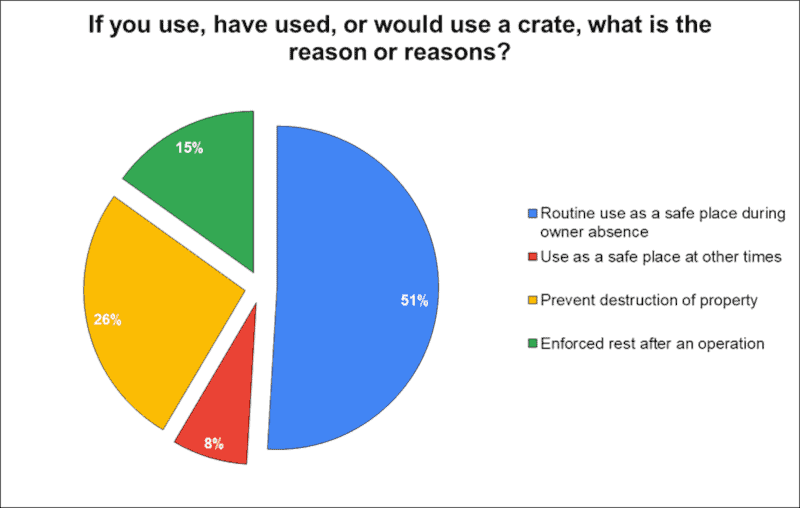
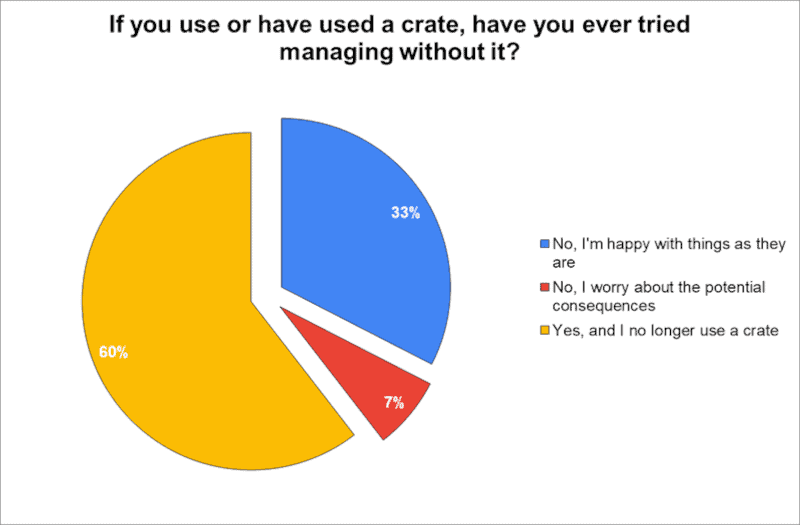
2. Longest continuous period in crate – Pre and Post Coronavirus
This was the area that I was particularly interested in – has Coronavirus had any impact on the use of crates? I looked at 2 areas – the longest continuous period and the longest total amount of time.
Unfortunately, I think perhaps my question phrasing wasn’t sufficiently clear as there is a figure of 38% for ‘None’ before Coronavirus.
That said, we can still see in when comparing Before and After that the ‘None’ proportion has increased and that the ‘Longer than 6 hours’ entry has gone completely.
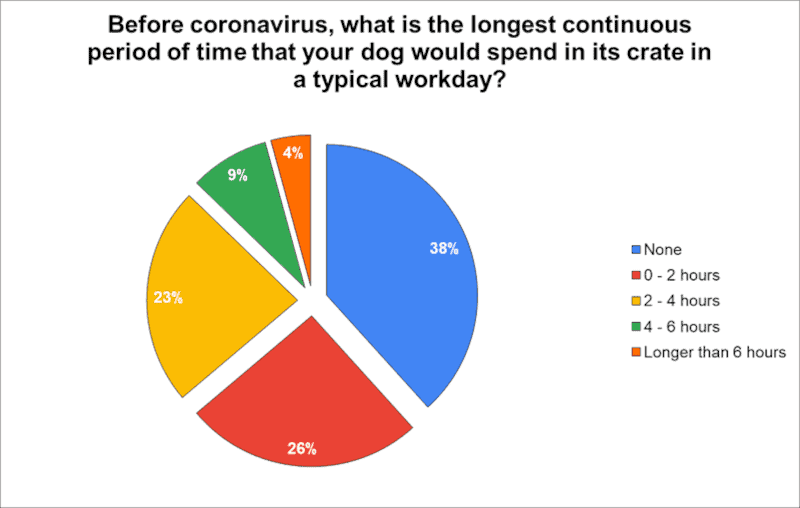
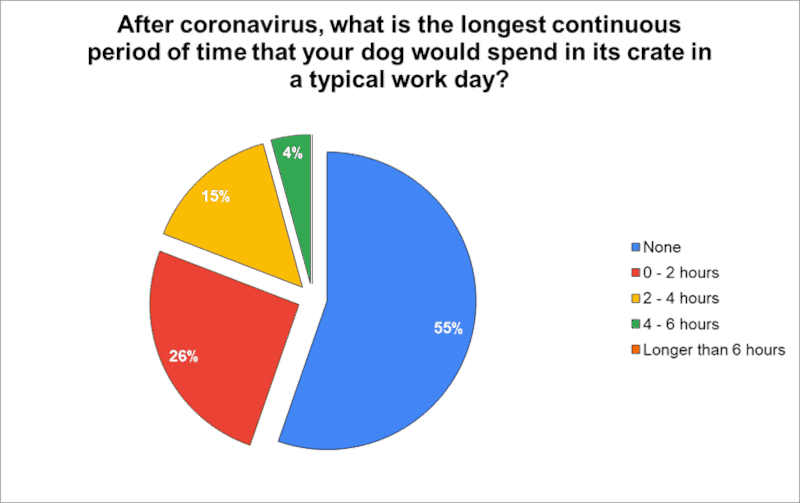
3. Longest total period in crate – Pre and Post Coronavirus
Again, we can see in the Before and After data that crate usage has decreased. In particular, we can see that there are no entries for longer than 8 hours and only 9% for the ‘4 – 8 hours’ category.
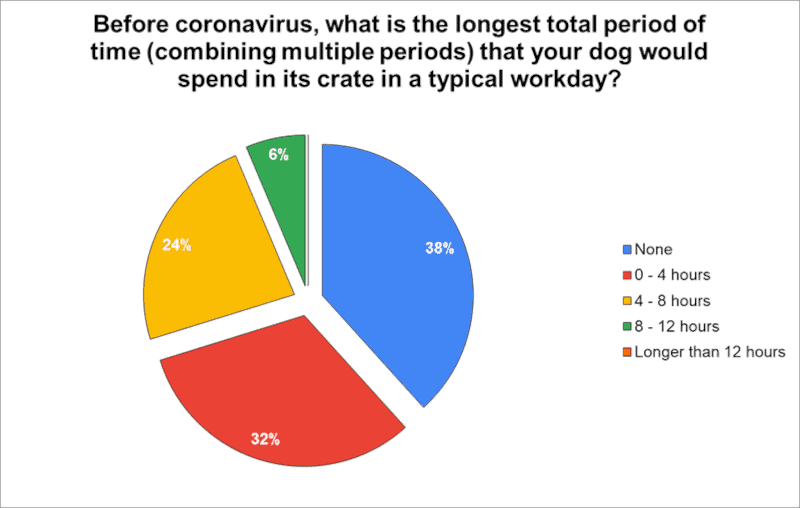
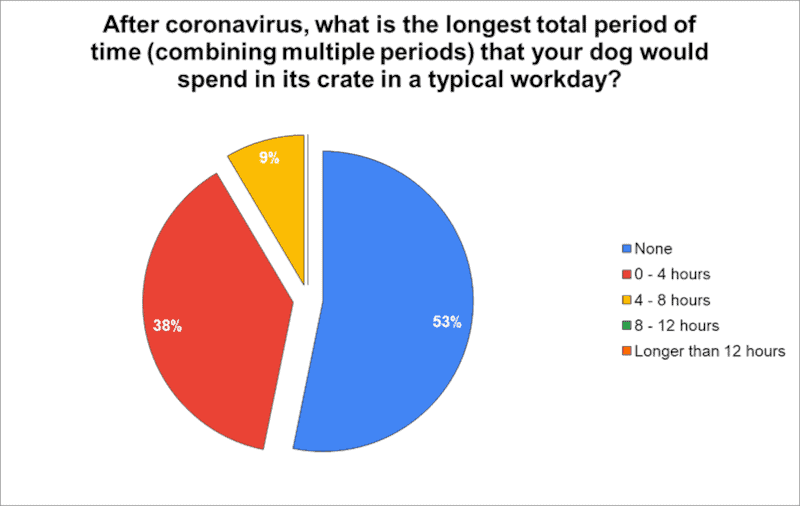
4. Reaction to being asked to use crate – Pre and Post Coronavirus
Here, I wanted to see whether there had been any change in the behaviour of dogs that use crates.
Note that the combination of those choosing ‘Hated it’ or ‘Reluctant’ went from a combined figure of 9% to just 2%.
And for a substantial proportion of respondents, the crate was no longer used at all (‘N/A’).
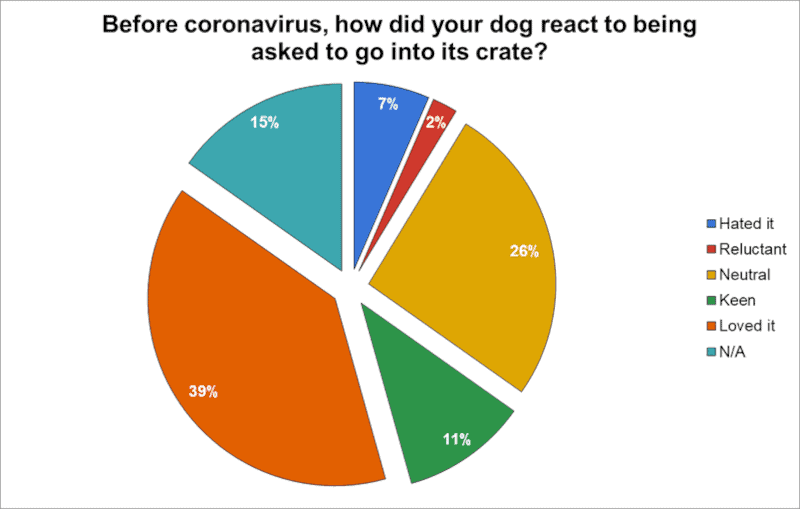
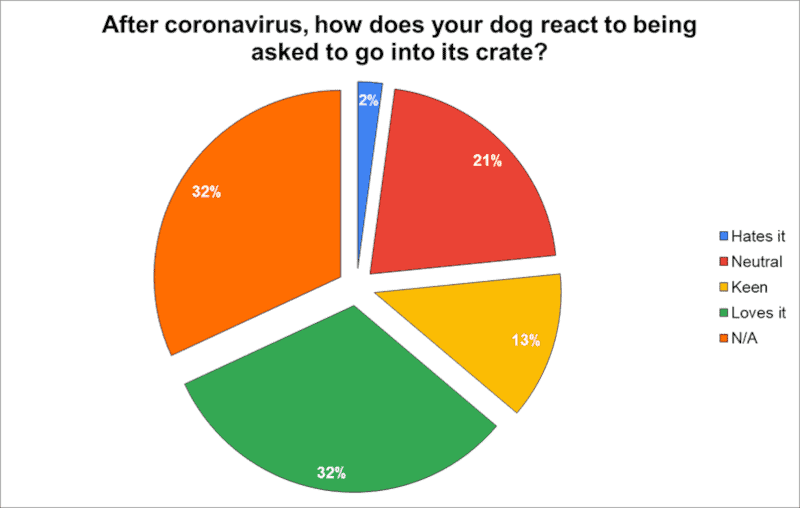
5. Crate use Post Coronavirus
Here we can see whether changes as a result of Coronavirus have had any impact on whether people will either stop using crates altogether or reduce their usage.
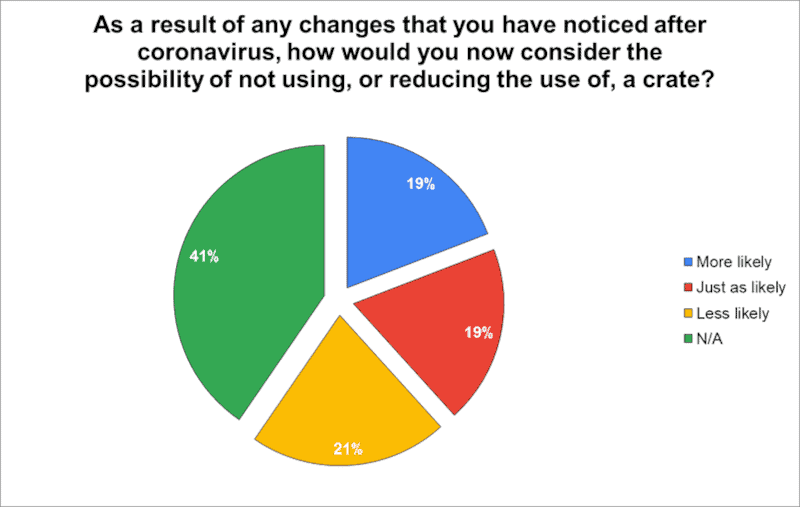
So, what do these results tell us?
Well, crate use certainly seems to have reduced as a consequence of the increased number of people now working from home. I think this probably indicates that people don’t crate their dogs for longer than is absolutely necessary – if they have to go out to work they use a crate, if they don’t, they don’t.
Let’s hope that something good can come from this pandemic and that those who wish to can work from home more frequently – and spend more time with their dogs. I’d certainly be happy with that outcome.
6 The Great Crate Debate – Conclusion
So, what is the answer to The Great Crate Debate?
Are crates Canine Cruelty or Dog Delight?
Well, as is often the case, I think the answer is ‘It depends’.
… whether your dog views it as five-star accommodation or a prison cell is up to you …
Sarah Whitehead
If they are correctly introduced to a dog and they are not used excessively then I believe that they are useful tools.
This view seems to be supported overwhelmingly by various organisations, vets, and trainers.
And, if you have concerns after reading the section about PETA and their views, I would invite you to read an article by Stanley Coren in Psychology Today.
It makes interesting reading and looks at the issue rationally (and psychologically!). The conclusion regarding the claims of PETA is summarised as follows:
I believe that PETA really has no scientific evidence to support the complete abolishment of the use of the kennel crate. It seems to me that their actual desire for banning crating is that in so doing they would make keeping dogs in the house more difficult and the housebreaking of puppies less reliable. This advances their anti-pet agenda by taking away some of the pleasure of pet keeping and in that way it would further their programme aimed at denying us the companionship of our dogs and cats.
Stanley Coren
If you do decide to use a crate then we have found the wire type to be excellent – solid construction but collapses easily when you need to move it or put it away. Easy to put up (and down), robust, and Harv loves being in his crate! (as you’ll have seen from some of the pics).
And so to bed …
7 Frequently Asked Questions
Here are some FAQs related to The Great Crate Debate. If you have any questions that you’d like to ask please let me know in the Comments section below.
Is it cruel to keep a puppy in a crate?
Crates are very useful tools and their use is not inherently cruel. What should be avoided is using them for excessively long periods of time. The RSPCA advises that dogs shouldn’t be left in a crate for longer than 3-4 hours.
Is it better to cover your dog's crate?
Covering a crate can be a good idea. Adding a ‘roof and sides’ by draping an old blanket over it can reinforce the feeling of safety and security experienced by a dog.
Should you put your puppy in a crate the first night?
Many people adopt a ‘start as you mean to go on’ approach and immediately put a new puppy into a crate.
However, keep in mind that this is your pup’s first night away from his mother and littermates and that he is sleeping in unfamiliar surroundings – it may be better, therefore, to have him in your room for a few nights until he is settled.
8 Acknowledgements
Image acknowledgements:
9 The End
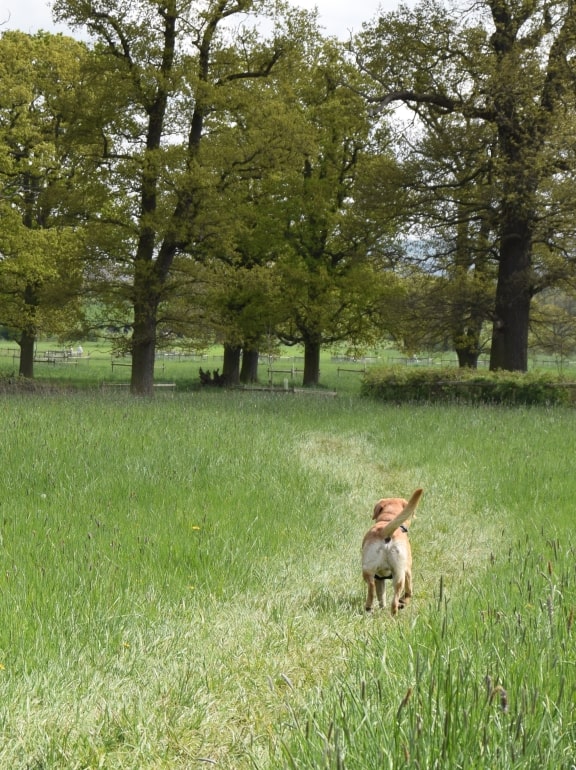
I hope that you’ve enjoyed this post.
Feel free to navigate around the site to see if there is anything else that may be of interest to you.
If you liked this post please share it. Thank you 🙂
If you’d like a heads-up when the next post is issued sign-up to the Richie’s Room Newsletter.
And, if you’d like to add a comment that would be great too – you can do that below.

A really interesting read. I only know of one dog owner that uses a crate/cage and have to say that it works really well and that the dog seems fine with it. He even takes himself off there when he fancies a nap. It’s a good size and in a place that’s not too warm or dark.
Hi Graham. Thanks very much for your feedback. Yes, our dog is the same.
Wow! So much awesome info! I recently became a dog mom back in December and boy has it been a learning experience! I thought that the “right” thing was to put him in a crate, so we tried it for the first night. He cried. Of course, he was only 8 weeks old. But, I took him out and snuggled with him, and now he’s 7 months, 65 pounds and still in my bed! haha I think there is definitely a place for crate training. I’m home all day with mine, and with Covid, we haven’t really had visitors. But, in a different world, I think we would have used a crate. I’m bookmarking your blog! Definitely want to read more.
Hi Natasha. Thank you for your comment – I’m glad that you enjoyed the post. And glad that you want to read more 🙂
Awesome post. Definitely it’s really terrific
and frightening to dogs..
Hi Gabi. Thank you for your feedback. What do you think is frightening to dogs?
Having grown up with 2 dogs, the idea of a crate had always baffled me. I just didn’t get why they would be needed – our dogs never had them and were left in the house for 7 hours some days with no issues. However, the idea of a comfort zone and safe area sounds reassuring. Thanks for sharing, I definitely understand better the purpose and use of crates – they aren’t cruel if used well.
Thanks, SS&GP. I think that in the UK at least, it is a relatively new thing. As you say, it’s all about using them responsibly.
Wow what a great and informative article! There are definitely pros and cons to each. I don’t have a dog currently, but we would love to get one someday so I will keep this information in mind!
Hi Charity. I’m glad that you enjoyed the post. Thanks for commenting.
Great coverage of the topic. So many resources here. I put the Stanley Coren article on my to-read list. Although I doubt anything will change for me because I’m not even going to say I use a crate. My dog uses a crate and goes in and out at will. It’s just a comfortable space with lots of cushions and a blanket and things stolen from around the house (Lol!). It’s super comfy in there and the door is NEVER closed. I was even thinking of removing the door to save space. I think I may get bit if I was to get rid of that crate. For my dog it’s a much loved space.
Hi Miche. Thank you very much for your kind words and for sharing your crate experience.
Your post brought back the old memories of my dog. I think it depends on the dog owner’s lifestyle, the dog’s personality, and how one uses the carate. It’s interesting to see how pandemic has reduced the use of crates.
Thanks for sharing the videos along with a great post, Richie
Dane. xx
Hi Dane. Thank you for your comment. I completely agree, I think ‘it depends’ pretty much sums it up.
This is such an interesting post, especially as there are so many disagreements about whether crate training is right or wrong. I think it depends entirely on the individual owner and dog. I crate trained my puppy and think she really benefited from it. She’s now 8 and only uses a crate for travel but I definitely think it helped in those early years.
Thanks for letting me have your feedback, Kelly. Yes, I think a lot of people use crates during the puppy phase and then phase them out afterwards.
This was such an interesting post, something I have never thought about before. We have a crate which is only used when really needed I.e there is a baby around, travel etc. Otherwise, I think dogs should be allowed to roam freely. I have nothing against crates, as you mentioned it is a good tool when used correctly. Thank you for this thought provoking post! Em
Thanks for your comment, Em, it is much appreciated. I’m pleased that you found it interesting.
Very interesting read! I’ve always had crates when I’ve had new puppies and never really thought of it as an issue. The door was also open in the day and they never went in with an issue. Perhaps because I’ve always had two dogs (so an older dog and then a puppy), the puppy never minded going in a crate at night, since there was another dog nearby (we just have a dog bed when the dogs are trained and all that).
We use to find that my oldest (a German Shepherd) found comfort in the crate when there was a thunderstorm or something loud so we’d often get it out for her to help she likes feeling secured I think.
And I’ve just remembered – a few years ago, I was looking after 3 kittens, they were only two weeks old and had been left at the vets I was working at, but we brought them home and had a massive crate to keep them in whilst we were taking care of them (we let them out when we were in the room obviously and since I only worked two days at the vets they were let out frequently), the dog always wanted to go in and sleep with them.
I think it’s definitely important to know how to use it properly, to make sure it’s a place of comfort, a resting place, that’s it’s large enough, comfortable enough, with food and water obviously.
They are not a place to lock the dog up because it’s annoying you.
That’s the main issue I think people have with crates because they know that some people will not use them properly. A dog, or any animal, that is brought into your life is a part of your family and should be treated with respect and love.
Hi Isobel. Thank you very much for leaving such a detailed comment. I completely agree: much like Jordan North and Turf Moor, the crate needs to be the puppy’s/dog’s ‘Happy Place’.
This is such a helpful post to anyone who’s struggling to decide whether to use a crate! We personally didn’t but not because we thought it was wrong, just because we didn’t think about it! It definitely has it’s pros and cons!
Thanks, Jenny. I certainly hope it is helpful to anybody weighing up whether or not to use a crate.
Like most things, I think there are good reasons for using crates and not so good reasons. Your point about a convenience for humans is spot on. But your point about safe socialisation when introducing dogs to cats, for example, is also right. If we were ever to get a dog, a crate is something we’d have to use as otherwise our 3 cats would leave and never come back!
Hi Lisa. Yes, precisely, they are a tool and, like all tools, you need to know when they are needed and how to use them properly.
Really interesting points in here, lots to consider! My grandparents always swore by their dog cages…
Hi Conor. Thanks very much for your feedback. That’s interesting – I tended to think that dog crates were a relatively recent invention.
A really interesting post and reading about both sides of the debate. Very informative and helpful!
Thanks for your comment, Della. I’m pleased that you found the post to be interesting.
Wow this was packed full of information that I didn’t know – although I am a cat owner! As a cat owner and a foster mom though, I enjoyed the snippet about using the crate to guide socialization. I also found it interesting in some similar techniques – yes sometimes cats need crates too (when rescuing a pregnant feral) and they absolutely love it covered to feel safe and protected.
Hi Janelle. Thank you for your feedback – always nice to get the perspective from my cat-owning readers 🙂
Wow! This is a really informational post. As for the to use crate or not, I guess it depends on the dog’s personality and liking. Right?
Thank you, Vybav. Glad that you enjoyed it.
There was so much useful information here. I did not know a lot of these perspectives because all you really hear about is what the sales people want you to know. It’s great to know more about how the animals truly feel about crates. Thank you for putting this information together.
~ Andrea | acaponeconnection.com
Hi Andrea. Many thanks for taking the time to comment – much appreciated.
I love that you’ve created pros and cons, that will really help dog owners. I know that it is a necessity for some and not used by others. My sister’s dog sits in hers if she needs to and is fine. She’s not in it for prolonged periods of time though
Rosie
Hi Rosie. Thank you very much for your comment.
This is such an informative post! Some things I wouldn’t have even thought of, like taking the dog’s collar off so it doesn’t get caught. I don’t have a dog, but have had friends who used crates for varying reasons. I like the quote “whether your dog views it as five-star accommodation or a prison cell is up to you.” That makes a lot of sense and helps put things in perspective.
Hi Alison. That’s very kind of you to say, thank you.
Interesting article! I had dogs growing up and they never had crates. When they were puppies we would have a section of the kitchen cornered off so they didn’t wee on the carpet and when they were trained we took it away!
Corinne x
Hi Corinne. I’m pleased that you found the post to be interesting. Thanks for your comment.
I have never heard of the great crate debate, so I was intrigued reading both sides of the story, as well as your handy tips and guidelines. It is important to do something well, respectfully, and kindly to get the best results, no matter what you are using.
My dog is ten years old, and we used a crate not as a training device but as a place for her to stay inside until she was old enough to move outdoors. We are also currently looking for a puppy and will likely do the same again, as it is an easy way to have a temporary dog home in the house. 🙂
Thanks for sharing!
Hi Jaya. I quite agree, respect and kindness go a long way in all types of training.
Interesting results from your survey and a great read.
We have a large dog and a 5 kids. When he was a puppy and as he got older maybe his first year and a half we had him crate trained, if we went out especially as a puppy he would go in his crate. The thing for him it was like his own space, he could be laid in the living room with us and the kids and if it got too loud he would take himself off for a snooze in his crate.
With the kids older now and he has matured we have no need for his crate anymore. Their are certain benefits to both points. I always felt guilty when we had the crate and would put him in if we went out.
Hi Eddie. I’m glad that you enjoyed the read and found the survey results interesting. Thanks for providing your feedback.
Fascinating!
I use a crate for my dog – but it’s only used rarely to keep her confined, say if my 1 year old nephew is learning to walk. The rest of the time she’s free to roam and sleep pretty much anywhere. But her crate is her space, she knows if she goes in she won’t be disturbed, it has a soft bed and mounds of blankets, plenty of balls. If she wants a rest she just takes herself away.
It was handy for enforcing rest after her operation and seizures too, she’s a terrier cross so full of energy and bounce that would be otherwise difficult to surpress.
Cora | https://www.teapartyprincess.co.uk/
Hi Cora. Thank you – anytime I get a ‘Fascinating!’ I know I’m doing something right 🙂 Thanks for the feedback on your crate use too.
I’ve never known anyone to use a dog create for any reason. I had a dog growing up and we never used a dog create, nor have any of my family and friends who have had dogs. Are dog creates even used in the UK or is it one of the those American things like always keeping your dog outside and having dog houses? Unless a dog is dangerous and needs to be transported, I don’t really see any other reason forna cage to be used that couldn’t be achieved with other methods
Thank you for your comment, much appreciated. Yes, crates are quite common in the UK and even more so in the US. Not so much in other countries.
This was such an interesting read! I had multiple dogs growing up but never used a crate and it always worked fine for our family. I think it’s a great idea as a safe space for them, but when we were out at work or school they used to be alone in the house for 6\7 hours unsupervised and be okay. Sure there was the accidental mischief but nothing serious. Thanks for sharing 🙂
Hi Cristina. I’m pleased that you found the post to be interesting. Thanks for your feedback on crate use for your dogs.
As a kid, my family never used dog crates – it was the 80s and 90s, they weren’t super common – but after one troublesome dog, we started crate training, and now I think it’s so important. Both for dogs who get into trouble when left alone, but also for any dog who may one day have an injury that needs rest and confinement, or just a safe space. If owners crate train properly, and make the crate a safe space, it can be really good for the dog. Thanks for bringing awareness to that.
Hi Jasmine. Thank you very much for taking the time to comment, I appreciate it.
A very interesting read! My other half and I both had dogs when we first met, his dog was crate trained and mine wasn’t. Both dogs were extremely happy, and my dog even enjoyed going in the crate when at the OH house which was left open at all times (it was basically a bed for Cara, my OH dog since she was trained). I think I done right and not used to keep the dog in without proper knowledge it can be a good tool for helping raise a dog.
Hi Jordanne. I’m glad that you found the post to be interesting. Thanks for your feedback on crate use by you and your OH.
It is a very informative post! I think the use of crates depends on each specific situation, like for transportation, as you discuss. However, at home, dogs should not be locked in crates. I also do not use these.
Thanks, EEssays. I’m glad that you found the post to be informative.
I don’t think PETA actually likes animals since they refuse to accept the fact that animals are different than people. I think they’re against crates just because they wouldn’t want to be in a crate.
Hi Gene. Thanks very much for your comment. Yes, I suspect that your assessment of PETA is correct.
To be honest, I take anything PETA says with a grain of salt. I’ve had a few friends who have done crate training and it’s worked really well! It’s given their puppy a safe space to go to sleep when they’re young and a protected place when they’re travelling. I can’t really talk since I’ve only ever had cats! xD
As long as your dog is safe and not in any distress, then it’s fine with me!
Thanks very much for your comment, Daisy. Yes, I think that you are probably right about PETA.
PS: I like cats too (and so does Harvey!) 🙂
Excellent post! As a vet tech I will point out that dogs who have been crate trained are less likely to become stressed when staying in the hospital or require anti-anxiety medications.
Thank you, Dawn. Glad that you enjoyed it. The point regarding hospital stays is an important one.
This was really interesting Richie. I don’t have a dog but I’ve always thought putting them in crates was cruel because it’s more about our convenience than the dog’s comfort and safety. I understand, after reading your post, that there are a variety of reasons to use a crate.
I am concerned that people who bought puppies or dogs during the pandemic will abandon them once life returns to normal. I hope that’s not the case, but it does concern me.
Hi Michelle. Thanks for your feedback. Yes, two sides to every story. I share your concern about ‘pandemic puppies’ – I really hope that these new owners continue to look after their new family members.
This was a really interesting read. Really well researched and lots of thoughts and angles that hadn’t occurred to me.
Thanks for your comment, Morag. I’m pleased that you found the post interesting.
This is such an informative article- Me and my family have been adopting dogs for more than a decade now and we’ve never thought about putting them in a crate because we thought it would be cruel.
Personally, I love seeing our pets running and playing outside freely. This article gave me new perspectives about using crates and their benefits. Thank you so much for sharing.
Hi Jocelyn. Thank you for your kind comment and for your feedback regarding crate use.
Very interesting read. Personally, I’d never put my dog in a crate, it’s just not something I want to do. I have no issues with other people using them, if it’s done correctly though.
Hi Adam. I’m glad that you found the post to be interesting. Thanks for your feedback regarding crate use.
Interesting post! I’ve never really heard anything about crates being bad for dogs. I think if you have locked up in there for ridiculous hours, then it could be a problem. It could depend on the owner as well, some may use them and some may not see the need for it. Great post!
TheQuietGirl
Hi Anissa. Thank you very much for your comment and feedback regarding crate use. Much appreciated.
Well, I don’t think they would need a crate at home… maybe only for when there’s people over.
Thanks for the comment, Joe. Much appreciated.
This is such an informative post. I never weighed the pros and cons previously when it came to crates!
Thank you, Jupiter. Glad that you found the post to be informative.
Good knowledge sharing. I never know that dog cage is actually call great create. This is something new for me. Thank you for sharing.
Hi Fadima. Many thanks for your comment.
Very interesting and informative read! We had a crate when our dog was a puppy, however it’s not something we use any more. I don’t think either of us enforced a strong enough routine. Not that I think it particularly matters now. Looking at my dog now, six years later, she’s quite happy to lay in her bed, in her own time and use that as her safe space.
Claire.x
Hi Claire. Thank you very much for your kind words. Yes, I suspect that a large number of people use a crate when their dog is young and then dispense with it later.
This is such an interesting read, I’ve never had a dog, but I think it depends on the person and your home set up!
Hi Amie. Thanks for your feedback. I agree, it’s often a case of ‘it depends’.
This is fascinating! We’re getting our first puppy next year and I have already started researching, and one area I just hadn’t really seen anyone discuss was crate training. All the trainers I’ve seen have recommended them if they are introduced slowly and carefully, and I do like the idea of having a space where my dog feels safe and can retreat to. I’m at home all day so it wouldn’t be something we used much, but it feels like it would reassure me to have a crate space! Thanks so much for sharing this diligently researched and informative piece, it’s really helped me with my decision!
Thanks for your comment, Bethany. It sounds as though the post was timed just right for your considerations! I’m pleased to see how much preparation you are doing for your new arrival – keep up the good work.
We crate trained our little dachshund from 8 weeks old and she absolutely loves her crate. It’s become her safe place from loud noise and anything which causes her great anxiety (like fireworks). We’ve found it really useful as does she. She actually asks us to go into her crate around 10pm every night haha. Xo
Elle – ellegracedeveson.com
Thank you, Elle, for taking the time to comment and share your crate feedback. Much appreciated.
Really interesting post – especially understanding both sides. We don’t have a dog but I’ve always found the use of cages quite wrong esp as some can be the wrong size. As long as the dog is happy!
Thanks for your comment, Alice. Thanks for the crate feedback, too.
Some fantastic advice here buddy, I really enjoyed reading this indeed. It’s good to see your blog is going well.
Thanks, Luke, your comment is much appreciated.
This post caused a debate between me and my partner about dog crates. It’s such a hot thing to talk about, being that he’s been around dogs that didn’t need them or have them and I’ve always seen dogs with a crate to sleep in or use for a ‘safe place’. I feel like it’s such a personal preference; neither is right or wrong on this subject.
Thank you, Sarah, for your comment. Hope things didn’t get too heated with your partner! 😉 And I suspect that your conclusion is spot on.
Very interesting post, Richie! This actually came at the right time because both of my SIL’s got puppies this spring! We’ve been talking about it a bit and I’ll share some of this info. Thanks!
Lynn | https://www.lynnmumbingmejia.com
Hey Lynn. It is an interesting topic, isn’t it? Itchy, but interesting!
This was such an informative post! We tried crate training our puppy but because she was a rescue and her foster parents didn’t ever put her in a crate, we struggled a lot! It really just depends on the dog doesn’t it!
Katy | http://www.katystephenson.com | http://www.thegrownupsclub.com
Hi Katy. I’m glad that you enjoyed the post. Yes, you are absolutely right – some just don’t take to it. Thanks for commenting.
This was really informative! I have so many friends who are currently having this debate I will pass this on!
Thanks for your comment, Molly. Yes, by all means, please do share it with your friends.
Interesting post! For my dog personally, we don’t use a crate for him because he gets very bad separation anxiety. But actually, we have a crate for my cat that she’s free to come in and out of if she wants. I view it as an alternative sleeping area, and she loves it! But definitely agree that the purpose, size, and reason matter immensely. Thanks for sharing!
Hi Alexis. Thank you for your comment, much appreciated.
I’ve never had a dog but I am thinking that if you research and train your dog right, it’s likely not harmful or mean to have them use a crate. I love animals and sometimes it’s just necessary to separate them from other animals or dangers in the home and a crate is a good way to do that.
Hi Giulia. Thanks for your feedback – I completely agree.
How does crate use reduce separation anxiety? It almost seems as if it would have the opposite effect.
Hi WW. That’s a good question. It’s all about the crate being seen by the dog as a safe place – somewhere that it can feel protected and comfortable until its owner returns. This will allow many dogs to settle down. It also helps to prevent the dog from injuring itself while it is on its own. That said, for a serious case of separation anxiety, I would always recommend consulting with a behaviourist and being guided by them.
What an informative post Richie! It’s a really tough one. I think that sometimes it might be necessary to put your dog in a crate, but only when it’s really necessary and not for long periods of time. I know people who put their dog in a crate in the back of the car, but then my sister’s big dog just lies in the back without the need for a crate.
Hi Vourneen. Thanks for your comment – I’m pleased that you found the post to be informative.